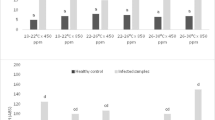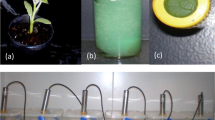Abstract
Experimental trials were carried out on bean (Phaseolus vulgaris L.)/Uromyces appendiculatus F. Strauss and pelargonium [Pelargonium zonale (L.) L’Hér.ex Aiton]/ Puccinia pelargonii-zonalis Doidge pathosystems, under phytotron conditions, to evaluate the effects of simulated elevated atmospheric CO2 concentrations, ranging from 800 to 850 ppm, compared with standard CO2, ranging from 400 to 450 ppm, and temperatures, ranging from 14 to 18, 18 to 22, 22 to 26 and 26 to 30 °C. A total of eight CO2 and temperature combinations were tested to establish their effects on the development of bean and pelargonium rusts. A doubled concentration of CO2, at the same temperature regime, was found to lead to an increase in U. appendiculatus disease severity on the beans. The combined CO2 and temperature factors significantly influenced the severity (p = 0.049) of the rust caused by U. appendiculatus. Moreover, Puccinia pelargonii–zonalis was observed to be more severe on pelargonium at the lowest tested temperatures, that is, between 14 and 22 °C. A high CO2 regime was shown to significantly increase disease severity at such temperatures. At the highest tested temperatures, that is, between 26 and 30 °C, which are generally not favourable for rust development, the increase in CO2 had no significant effect on disease severity.





Similar content being viewed by others
References
Ainsworth, E. A., & Long, S. P. (2005). What have we learned from 15 years of free-air CO2 enrichment (FACE)? A meta-analytic review of the responses of photosynthesis, canopy properties and plant production to rising CO2. New Phytologist, 165, 351–372.
Chakraborty, S. (2013). Migrate or evolve: options for plant pathogens under climate change. Global Change Biology, 19, 1985–2000.
Chakraborty, S., Murray, G., & White, N. (2002). Potential impact of climate change on plant diseases of economic significance to Australia. Australasian Plant Pathology, 27, 15–35.
Coakley, S. M. (1979). Climate variability in the Pacific Northwest and its effect on stripe rust disease of winter wheat. Climatic Change, 2, 33–51.
Coakley, S. M., Scherm, H., & Chakraboty, S. (1999). Climate change and plant disease management. Annual Review of Phytopathology, 37, 399–426.
De Vallavieille-Pope, C., Huber, L., Leconte, M., & Goyau, H. (1995). Comparative effects of temperature and interrupted wet periods on germination, penetration and infection of Puccinia recondita f.sp. tritici and P. striiformis on wheat seedlings. Phytopathology, 85, 409–415.
Dixon, L. J., Castlebury, L. A., Aime, M. C., Glynn, N. C., & Comstock, J. C. (2010). Phylogenetic relationships of sugarcane rust fungi. Mycological Progress, 9, 459–468.
Ferris, R., & Taylor, G. (1994). Stomatal characteristics of four native herbs following exposure to elevated CO2. Annals of Botany, 73, 447–453.
Ferrocino, I., Chitarra, W., Pugliese, M., Gilardi, G., Gullino, M. L., & Garibaldi, A. (2013). Effect of elevated atmospheric CO2 and temperature on disease severity of Fusarium oxysporum f.sp. lactucae on lettuce plants. Applied Soil Ecology, 72, 1–6.
Franks, P. J., Adams, M. A., Amthor, J. S., Barbour, M. M., Berry, J. A., Ellsworth, D. S., Farquhar, G. D., Ghannoum, L. O., McDowell, N., Norby, R. J., Tissue, D. T., & von Caemmerer, S. (2013). Sensitivity of plants to changing atmospheric CO2 concentration: from the geological past to the next century. New Phytologist, 197, 1077–1094.
Gautam, H. R., Bhardwaj, M. L., & Kumar, R. (2013). Climate change and its impact on plant diseases. Current Science, 105, 1685–1691.
Gerecheter-Amitai, Z. K., Sharp, E. L., & Reinhold, M. (1984). Temperature-sensitive genes for resistance to Puccinia striiformis in Triticum dicoccoides. Euphytica, 33, 665–672.
Ghini, R., Hamada, E., & Bettiol, W. (2008). Climate change and plant diseases. Scientia Agricola, 65, 98–107.
Gilardi, G., Pugliese, M., Chitarra, W., Ramon, I., Gullino, M. L., & Garibaldi, A. (2016). Effect of elevated atmospheric CO2 and temperature increases on the severity of basil downy mildew caused by Peronospora belbahrii under phytotron conditions. Journal of Phytopathology, 164(2), 114–121.
Gregory, P. J., Johnson, S. N., Newton, A. C., & Ingram, J. S. I. (2009). Integrating pests and pathogens into the climate change/food security debate. Journal of Experimental Botany, 60, 2827–2838.
Groth, J. V., & Mogen, B. D. (1978). Completing the life cycle of Uromyces phaseoli var. typica on bean plants. Phytopathology, 68, 1674–1675.
Grünzweig, J. M. (2011). Potential maternal effects of elevated atmospheric CO2 on development and disease severity in a Mediterranean legume. Frontiers in Plant Science, 2, 1–9.
Gullino, M. L., Pugliese, M., Paravicini, A., Casulli, E., Rettori, A., Sanna, M., & Garibaldi, A. (2011). New phytotrons for studying the effect of climate change on plant pathogens. Journal of Agricultural Engineering– Rivista di Ingegneria Agraria, 1, 1–11. doi:10.4081/jae.2011.1.1.
Harvood, C. A., & Raabe, R. D. (1979). The Disease cycle and control of geranium rust. Phytopathology, 69, 923–927.
Helpher, S. (2014). Rust fungi and global change. New Phytologist, 201, 770–780.
Hetherington, A. M., & Woodward, I. F. (2003). The role of stomata in sensing and driving environmental change. Nature, 423, 901–908.
Kaur, S., Dhaliwal, L., & Kaur, P. (2008). Impact of climate change on wheat disease scenario in Punjab. Journal of Research, 45, 161–170.
Manning, W. J., & von Tiedemann, A. V. (1995). Climate change: potential effects of increased atmospheric carbon dioxide (CO2), ozone (O3), and ultraviolet-B (UVB) radiation on plant diseases. Environmental Pollution, 88, 219–245.
Mboup, M., Bahri, B., Leconte, M., De Vallavieille-Pope, C., Kaltz, O., & Enjalbert, J. (2012). Genetic structure and local adaptation of European wheat yellow rust populations: the role of temperature-specific adaptation. Evolutionary Applications, 5, 341–352.
Mina, U., & Sinha, P. (2008). Effects of climate change on plant pathogens. Environment News, 14(4), 6–10.
Park, S., Chen, Z.-Y., Chanda, A. K., Schneider, R. W., & Hollier, C. A. (2008). Viability of Phakopsora pachyrhizi urediniospores under simulated southern Louisiana winter temperature conditions. Plant Disease, 92, 1456–1462.
Peters, G. P., Marland, G., Le Quéré, C., Boden, T., Canadell, J., & Raupach, M. R. (2012). Rapid growth in CO2 emissions after the 2008–2009 global financial crisis. Nature Climate Change, 2, 2–4.
Pfender, W. F., & Vollmer, S. S. (1999). Freezing temperature effect on survival of Puccinia graminis subsp. graminicola in Festuca arundinacea and Lolium perenne. Plant Disease, 83, 1058–1062.
Pugliese, M., Gullino, M. L., & Garibaldi, A. (2010). Effects of elevated CO2 and temperature on interactions of grapevine and powdery mildew: first results under phytotron conditions. Journal of Plant Diseases and Protection, 117, 9–14.
Pugliese, M., Cogliati, E., Gullino, M. L., & Garibaldi, A. (2012a). Effect of climate change on Alternaria leaf spot of rocket salad and black spot of basil under controlled environment. Communications in Agricultural and Applied Biological Sciences, 77, 241–4.
Pugliese, M., Liu, J., Titone, P., Garibaldi, A., & Gullino, M. L. (2012b). Effect of elevated CO2 and temperature on interactions of zucchini and powdery mildew. Phytopathologia Mediterranea, 51, 480–487.
von Tiedemann, A. V., & Firsching, K. H. (2000). Interactive effects of elevated ozone and carbon dioxide on growth and yield of leaf rust-infected versus non-infected wheat. Environmental Pollution, 108, 357–363.
Woodward, F. I., & Kelly, C. K. (1995). The influence of CO2 concentration on stomatal density. New Phytology, 131, 311–327.
Wynn, W. K. (1976). Appressorium formation over stomates by the bean rust fungus: Response to a surface contact stimulus. Phytopathology, 66, 136–146.
Acknowledgments
The research leading to these results has received funding from the European Union’s Horizon 2020 research and innovation programme under grant agreement No 634179 “Effective Management of Pests and Harmful Alien Species - Integrated Solutions” (EMPHASIS). The authors kindly thank Marguerite Jones for the language revision.
Author information
Authors and Affiliations
Corresponding author
Rights and permissions
About this article
Cite this article
Gilardi, G., Puglliese, M., Gullino, M.L. et al. Simulated elevated atmospheric CO2 and temperature affect the severity of bean and pelargonium rust. Phytoparasitica 44, 325–332 (2016). https://doi.org/10.1007/s12600-016-0533-2
Received:
Accepted:
Published:
Issue Date:
DOI: https://doi.org/10.1007/s12600-016-0533-2




